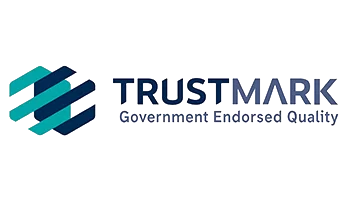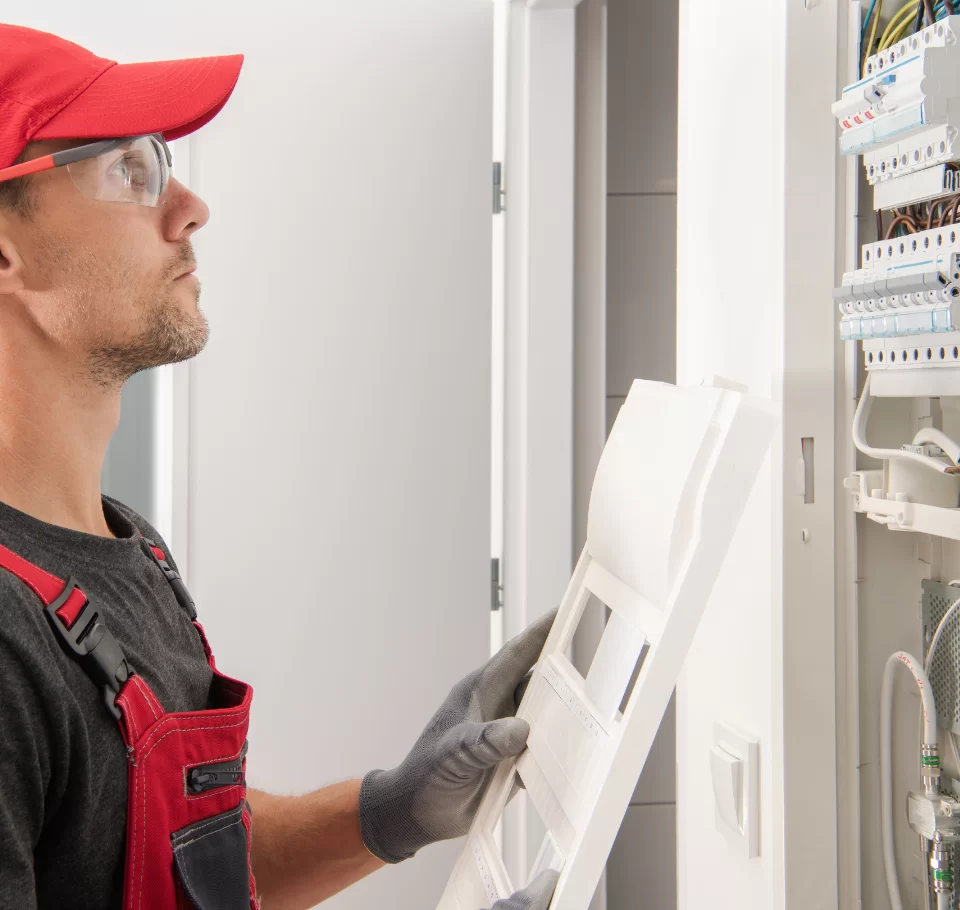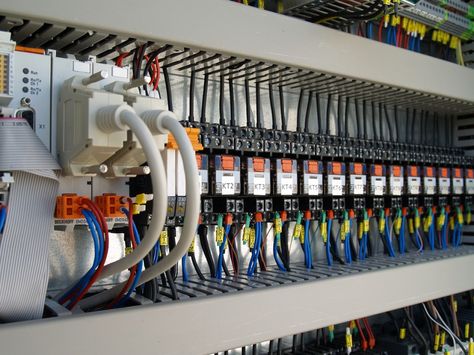How easy is the process?

Core Areas We Serve – Others on Request







| Property Size | Price |
|---|---|
| Studio | £80 |
| 1 Bedroom | £90 |
| 2 Bedroom | £100 |
| 3 Bedroom | £110 |
| 4 Bedroom | £120 |
| 5 Bedroom | £130 |
| 6 Bedroom | £140 |
Prices exclude VAT.
Discounts available for multiple bookings

Core Areas We Serve – Others on Request
Our qualified and experienced electrical inspectors will carry out visual checks and dead and live testing of the wiring, circuit accessories, and switchgear in the property.
These electrical items will be checked in accordance with BS7671 to verify compliance with the regulations, and to see if the condition of the items is satisfactory so as not to present a safety risk to the user.
If any defects are identified (C1, C2, C3, FI) during the EICR test, we will provide an explanation of these defects and highlight this on the EICR certificate. We will also provide an itemised quotation to repair these defects along with advising of any different options available regarding the repair.
Once instructed to proceed with the remedial work we will bring the property up to a safe and compliant condition. We then issue you with certification for the repairs undertaken and a Satisfactory EICR.
Read more about the different types of defects that might occur
You might be asking yourself why EICR reports are so important. Well, electrical installations and components can deteriorate over time due to poor connections, faulty parts, rodent damage and other building issues.
An EICR electrical installation certificate is the best possible method of highlighting any electrical problems before they become a safety risk.
Whilst general user visual inspections could identify any damaged sockets/switches that are a safety risk they are unlikely to detect any unseen dangers and potential risks, or regulatory non compliances.
Therefore, it is better to keep in line with EICR electrical test procedures to ensure that the installation is in a safe condition.
If the residential property in question is to be rented out to a tenant, then it is a legal requirement for the property to have a Satisfactory EICR status.
Read more about what electrical remedial works involve here.
Book EICR NowA domestic EICR electrical report is the official document produced after an inspection of a building’s electrical installation. If you’re asking yourself “how old is my electrical installation?” then it’s time you had it checked.
Domestic EICRs cover everything from consumer units to cabling/wiring and light fittings and socket outlets.
The electrical condition report will detail the condition of these parts of the electrical installation to help ensure your premises are compliant with BS 7671, the national standard for electrical installations.

A domestic EICR is a legal requirement for all residential/domestic rental properties and is recommended for all non-rented residential properties. Insurance companies may require a Satisfactory EICR for non-rented properties.
So, how long is an EICR valid for? The electrical certificate lasts for 5 years or change of tenancy/owner, then a new EICR needs to be undertaken.
If the property is rented and a change of tenancy occurs within 5 years, then in most cases a landlord’s visual inspection at the change of tenancy will suffice instead of a full EICR for legal compliance purposes.
In London and England, a Residential Electrical Installation Condition Report (EICR) is recommended for homeowners or landlords that require compliance with BS 7671.
EICR electrical inspections highlight most electrical problems before they have the chance to cause damage or injury.
Since 1st June 2020, Government regulations made it mandatory for landlords within the private rented sector to have their electrical installations tested every five years.
For older electrical installations, more frequent testing can be required.
A domestic EICR certificate is suitable for:

For homeowners, we provide peace of mind by checking that the electrical installation is in a safe condition and advising of regulatory compliance. If defects are identified, then we will provide an itemised quotation to rectify the installation to a safe condition.
By having a safe electrical installation in your home, you will be reducing the risk of fire and other dangerous electrical events such as electrical shock.
Ensuring well-maintained electrics through an electrical condition report will add value to your home and prevent any last-minute negotiations if you ever decide to sell your property.
For more information, take a look at our EICR prices page.
Hexo Electrical Testing provides high quality specialist electrical testing for landlords in London and the South East to ensure electrical safety for any rental property.
The resulting electrical installation certificate will ensure that the landlord is legally compliant, providing that the defects are rectified to a Satisfactory EICR status.
Landlords should also be aware of their responsibilities for having EICRs for HMOs.
The EICR lasts for 5 years or change of tenancy, but we will only need to do a landlord’s visual inspection on change of tenancy if we have carried out the previous EICR test. Please contact us to arrange your landlord’s visual inspection.
It is a legal requirement for a landlord to have a Satisfactory EICR– without one the landlord is liable to prosecution.
Take a look at our EICR prices page.
Read more in our blog ‘Why is a Landlord Electrical Safety Certificate so Important’
Whether you are a builder or architect, it is advisable to avoid any accidents or dangerous situations by instructing a specialist domestic electrical testing company to ensure your installation is electrically compliant.
To make sure the electrical installation is safe and works properly, an electrical installation condition report (EICR) is the perfect way to demonstrate compliance.
Click here for EICR prices.
Whenever you develop properties, attention must be given to the safety of the electrical installation. To make sure your developments are legally compliant and safe for your customers, it is advised to carry out an EICR test after you’ve completed your project.
Speak to our sales team to negotiate a special rate for large scale projects.
As a property manager, you are responsible for your property portfolio and having the correct electrical safety certificates.
It is therefore essential for you to make sure the properties you manage are in good electrical condition to ensure safety and avoid tenant or customer complaints in the future.
Additionally, it can give you more bargaining power and security when you know that everything is safe after an electrical condition report has been carried out.
Housing associations and councils in London need to ensure their members and social housing tenants are provided with a safe and compliant electrical installation.
An independent EICR by Hexo Electrical Testing will provide an accurate report on the condition of the electrical installation, and will arm you with the knowledge that your system is safe and reliable.
Book EICR Now
In order to make a property insurance claim you will probably need to have a valid EICR in place to show that the property meets the electrical safety standards.
Landlords and homeowners should check if their insurance policy includes this requirement.
It’s best practice to have a full EICR carried out every five years, so it’s likely your insurance company will require you to keep up to date with EICR regulations. If in doubt, speak directly with your insurance provider.
Electrical installation condition reports involve various checks, from fuse boards or consumer units, through to the sockets/switches and fixed wiring within the walls.
The EICR test will highlight any defects with the electrical installation and provide solutions for rectification of these defects in accordance with BS7671.
During the domestic electrical testing, our inspector will identify any defects with the electrical installation and provide a coded observation for each. The coded observation will fall into one of the following four categories that range in severity:
The most severe observation code, a C1 means danger is present and there is an immediate threat to property and/or life.
Fast action to rectify the defect is mandatory and we are obliged to rectify the level of the defect from a C1 to at least a C2 during the inspection visit. Any number of C1 defects make the EICR Unsatisfactory or a Fail.
The C2 code means there is a potentially dangerous defect with your system and urgent corrective work is required.
The defect needs to be rectified within 28 days if the property is rented. Any number of C2 defects make the EICR Unsatisfactory or a Fail.
Code 3 is a lower-level code defined as ‘Improvement Recommended’, which means a regulatory issue has been identified or a part of the electrical installation could do with improvement. The installation may not comply with the latest regulations and amendments.
This is a formal recommendation for improvement but C3s are not required to be rectified as they do not affect the outcome of the EICR Satisfactory/Unsatisfactory. Pass/Fail.
Some organisations may require that C3 defects are rectified to achieve full compliance with the latest electrical regulations.

The FI code means that further investigation into a part of the electrical installation is required. This usually means that our inspector has found something during the electrical safety report that needs to be looked at in more depth.
Low insulation resistance readings may have been measured or there may be untraced electrical circuits in the installation. It is required to rectify any FI defects as FI defects make the EICR Unsatisfactory or a Fail.
If any defects are discovered during our electrical installation condition report inspection, we offer a remedial service to get your property safe and compliant quickly.
We will send your EICR by email and attach an itemised quotation for the rectification of the defects. We offer clear and fixed pricing for electrical remedial works.
Once the remedial works have been completed, then we issue you with a Satisfactory EICR. You can choose whether to rectify only C2 defects or C3 recommendations as well (Any C1 defects will usually have been rectified during the inspection visit).
If the property is rented, all C2 defects must be rectified within 28 days of discovery.
Read more on what’s involved with remedial electrical works here.
Book EICR NowDomestic EICRs last for either 5 years or change of tenancy/owner, whichever happens earlier.
However, if there is a change of tenant within 5 years of an EICR that we carried out then we can carry out a landlord’s visual inspection instead of a full EICR, this will ensure that the landlord is legally compliant for the new tenancy.
A new full EICR will be needed 5 years from the date of the previous full EICR regardless of the date of any visual inspections within that 5-year timeframe.
At Hexo Electrical Testing, we are experts in testing domestic electrical circuits and can provide expert services for landlords. Please contact us to discuss your requirements or if you have more questions about how long an EICR is valid for.
When it comes to domestic EICRs, or electrical safety reports, you need to ensure you understand government guidance. Under the Electrical Safety Standards in the Private Rented Sector (England) Regulations 2020, landlords have 28 days to arrange remedial works.
We’re always open and fair with our quotes for any remedial works. Check our prices page for more information here.
For landlords or property managers with an extensive portfolio of properties, we can set up a schedule of remedial rates and then we can complete most electrical remedial works on the same day.
This reduces the number of bookings needed and minimises disruption for your tenants, allowing you to meet the Electrical Safety Standards in the most efficient way.
Book EICR NowYou might be wondering if an EICR report is a legal requirement and asking yourself “how often should I get an EICR check?”.
Well, the answer is Yes, Government regulations make it mandatory for landlords within the private rented sector in London and across England to ensure their electrical installations are safe by way of a Satisfactory EICR every five years.
If you’re asking yourself “how long does an EICR test take?”, we typically advise that a residential or domestic EICR takes between one and four hours to complete.
However, how long the domestic electrical testing takes all depends on the size and condition of the property, as well as the number of circuits that need to be tested.
So, who can carry out an EICR? The answer is that it must be a qualified and approved electrical inspector. As EICR specialists, all our inspectors are qualified, approved, and experienced.
We are registered with NAPIT as an approved company for conducting electrical inspections/EICRs so you are in safe hands with Hexo Electrical Testing.
Find out more about us here!
Choosing who can carry out an EICR for your property is straightforward when you work with Hexo. We offer residential EICR certificates in London and the South East, working with landlords and homeowners to ensure compliance.
With our speedy remedial work and fast electrical safety certificate turnaround times, you can sit back and let us take care of your electrics.
Book EICR NowSo, how much does an electrical condition report cost? For residential properties, the cost of an Electrical Installation Condition Report is based on the number of bedrooms in the property.
An EICR cost per circuit only applies if the property has more than 8 electrical circuits, as we then charge an additional £15+VAT per additional circuit.
Finding electrical installation condition report costs is easy with Hexo Electrical Testing.
Visit our EICR prices page or use our online booking tool to calculate the price of your domestic EICR. Alternatively, you may contact us to get a bespoke quote.
Book EICR NowEvery service that we offer is performed in compliance with COVID-19 protocols. Our inspectors and engineers wear all the required PPE and are considerate of any further requests you may have.
We ask that you open all windows in the property to help with ventilation and be mindful of mask wearing and social distancing at all times.
All necessary Covid-19 precautions are taken and practised by our staff. So, if you’re looking for a Covid Safe EICR in London or the South East then contact us today!
During an EICR inspection, a series of tests will be carried out to determine whether there are any defects with the electrical installation and system.
This begins with a visual inspection to identify any obvious issues, before moving on to Dead testing and Live testing. Several other general checks and inspections are also carried out during the EICR inspection. The sequencing of the individual tests is up to the inspector carrying out an EICR, as the installation is already energised/live the sequence of tests becomes less important.
All relevant parts of the electrical systems will be included in the testing, such as cabling and wiring as well as switches, sockets, and consumer units.
Get a quick overview in our FAQs here
A Visual Inspection is usually the first stage in an EICR Electrical Certificate inspection. A qualified test engineer/inspector will visually inspect and check the condition of the electrical installation before moving on to the next steps in their testing.
This allows them to spot any visible issues, such as wires, cables and switches that have been damaged due to wear and tear and start to assess the general age and condition of the electrical installation.
Usually once a Visual Inspection has been completed, a process called Dead Testing will begin. This usually includes: Continuity Testing, Ring Continuity Testing, Insulation Resistance Testing, and may also include Polarity Testing.
There are two methods for carrying out continuity testing:
When carrying out continuity testing, we are verifying that the resistance of the cables and connections are within tolerances, and also that a physical connection exists.
Adequate earth continuity is required to all Class 1 equipment and is recommended to all parts of the electrical installation.
This test is performed to ensure that any ring circuits in the property are in fact rings and not radial circuits, or faulty ring circuits that have poor quality or lacking connections.
If a ring circuit is not a compliant continuous loop, then the overcurrent protection for the circuit may not provide adequate overload protection for the cable which is a potentially dangerous situation.
This test should also help detect any loose connections that may result in an electrical arc which could cause a fire.
This test is performed by energising either 250v or 500v of electrical testing voltage down all cables and through all switches and accessories.
The insulation resistance test is carried out between live conductors and earth and is used to detect any degradation in the cables or connected accessories that could pose a fire risk.
When carrying out an EICR it is not always possible to carry out insulation resistance testing between both live conductors as the installation usually has load connected which makes this impracticable.
This test may be undertaken during dead testing by the R1/R2/Rn test method, or the inspector may choose to verify polarity during live testing.
Polarity testing checks that the cables are connected correctly and that they are not cross connected which could pose an electrical shock risk.
On an EICR inspection the electrical inspector may choose to carry out live testing before dead testing, but the same live tests must be carried out.
This test is carried out at various points on each electrical circuit and the primary function of this test is to ensure that the measured reading of the earth loop impedance (Zs) is within the maximum limit for the protective device of the circuit.
By ensuring that the reading is acceptable we are verifying that the protective device (MCB, circuit breaker, fuse) will operate/trip within the time required by BS7671.
Earth Loop Impedance should also be measured as close to the origin (Ze) of the electrical installation as possible (usually at the consumer unit), this is to ensure that the DNO’s (District Network Supplier) main fuse will blow in the event of a fault.
Earth Fault Loop Impedance (EFLI) tests can also be used to verify polarity in the case the inspector prefers a live check of polarity.
Residual Current Devices (RCDs) are used to disconnect a circuit if there is an earth fault, preventing fatal electric shocks and providing protection against electrical fires.
The electrical inspector will test that in the event of an earth fault the RCD device operates within the time required by BS7671.
If either of these devices are present on your electrical installation then our inspector will check that they are functioning correctly.
During the EICR inspection the inspector will check a multitude of other items and record the findings, here are some examples of items that will be checked:
To carry out the dead testing safely and properly the inspector will have to turn off the power supply. Most of the testing is done while the wiring is live, so the power will be off for only a relatively short time and the inspector will inform you before this happens.
Hexo Electrical Testing provides remedial works in London and Greater London. The remedial works will be carried out by our specialist engineers, to bring your installation back in line with the current regulations.
We will issue you with an itemised quotation for any defects or recommendations pertaining to your electrical installation and then once instructed we will attend to carry out the repairs/upgrades.
According to UK law, some EICR (electrical safety certificate) outcomes involve obligatory remedial works: immediately for a C1 code, and within 28 days if you receive any C2 codes.
Find out more about what’s included in remedial electrical works here.
Did you know that the legislation regarding EICR reports has recently changed? Keeping up to date with amendments to the electrical regulations is important for well-performing safe installations; we will advise you of how compliant your installation is and recommend that if it is not fully compliant we carry out upgrades to make the installation fully compliant with the latest regulations and amendments.
It is not mandatory to be fully compliant with the latest regulations, but the installation must be deemed Satisfactory as a minimum.
According to government statistics, outdated electrical installations and faulty electrical systems account for almost half of accidental UK house fires, and about four injuries a day.
At Hexo Electrical Testing we can professionally check the safety of your electrical installation and repair any problems that may exist. Keeping your installation up to date will reduce the chances of an electrical dangerous occurrence.
It is increasingly common that insurance companies require a Satisfactory EICR for property insurance cover to be provided. You may see that regular domestic electrical testing is required as part of your policy agreement.
The insurance company will probably want to know that the condition of the electrical installation in the property is Satisfactory. Regularly keeping up to date with electrical regulations will prevent an unexpected major upgrade in the future.
Never procrastinate – the repairs may cost you more! Keeping your electrical system compliant is the best way of saving – issues identified early may prevent further damage. Being prudent and keeping on top of electrical repairs will save you money in the long run. Prevention is usually better than cure.
Find out more about the different types of electrical testing you may want to consider here.
Book EICR NowAm I allowed to carry out an EICR myself?
Only qualified professionals may carry out an EICR. You must have the qualifications and experience to check installations according to the 18th Edition of the Wiring Regulations and then be able to provide a report on it.
Additionally, you must be a member of an approved body or organisation, such as NAPIT, NICEIC and ELECSA. If you have all the correct documentation and qualifications and associations, then you can certify your own properties.
At Hexo Electrical Testing, we provide EICR certificates in London and the South East. We can issue EICR certificates for all types of residential properties and help with all the advice you may need. We can book an appointment with your tenant or vendor and take care of all the administration.
Just contact us today if you have more questions such as how long does an EICR last, or if you just want to learn more about domestic electrical testing.
We can also provide an estimate for electrical report costs, or alternatively you can book a domestic electrical installation condition report today with our online booking tool.
Book EICR NowDon’t leave your safety up to chance! We’re known for our speedy remedial work and our fast certificate turnaround times. By hiring a qualified engineer through Hexo who can issue an EICR certificate, you can let us do the hard work.
Just sit back and let us take care of your electrics, and you won’t have to worry about the safety of your family or legal compliance for your tenancies.
An EICR test in London will typically last between 1-4 hours depending on the size of the property, the accessibility of the electrical systems and the amount of circuits in the property.
After the electrical inspection is over, our electrical inspector will explain the result of the EICR test and we will send you the EICR certificate by email.
It will not only detail whether your electrical system has passed the EICR, but it will also list any remedial work required and inform you on the current condition of your electrical wiring.
An EICR will specify any deterioration, damages and defects which could be putting those who reside in your property at risk.
If your electrical wiring does not pass the EICR, then remedial work must be carried out to resolve this issue as soon as possible.
We will provide you with a detailed quote for any required remedial work.
If your electrical system does not pass the EICR, then it will be given a code depending on how severe the damage is.
As soon as your electrician has recommended these changes, you have 28 days to resolve any electrical issues.
As soon as we have sent your EICR certificate then if you are a landlords in the private rental sector you have 28 days to resolve any electrical issues.
The report should be available for your local authority as they may request a copy.
Typically, an EICR should be carried out once every five years. However, in some situations, more frequent inspections may be required.
This will depend on:
An EICR is documented proof that your property’s electrical systems are safe and you have complied with the safety requirements.
It also indicates that you have taken reasonable steps to ensure the safety of your staff and tenants.
You must share a copy of the EICR with the following individuals:
After the EICR test is carried out, we will then apply a label to the consumer unit, which will indicate the date of the next EICR inspection. The EICR report also shows the next inspection date.
There are some steps you can take to ensure that your EICR inspection runs smoothly.
You should read up on regulations surrounding EICR tests and inspections – knowledge is power.
Conduct a preliminary visual inspection yourself, and note down any visual problems. This will be helpful when the inspector comes to inspect your electrical systems.
Be ready to take relevant remedial action after your visual inspection, we may need a further visit to carry out remedial work and make the installation safe.
Make sure your tenants are informed in advance of any tests. They must be aware that their daily activities may be affected by interruption of power.